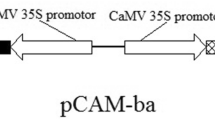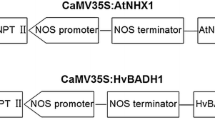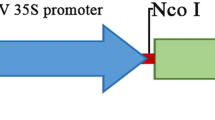Abstract
Salinity is an adverse environmental stress that limits the yield and quality of maize. As one of the most important osmolytes present in higher plants, glycinebetaine helps stabilize metabolism in plant cells and protects the constituents of cells from damage. In this study, a gene from Atriplex micrantha that encodes betaine aldehyde dehydrogenase was introduced by Agrobacterium-mediated transformation into maize inbred lines Zheng58 and Qi319 under the control of the maize ubiquitin promoter. Putative transgenic plants were confirmed by PCR and Southern blotting analysis. The transgenic maize plants expressed higher amounts of betaine aldehyde dehydrogenase activity and also grew better than the WT plants under NaCl stress. Compared with the wild type, the transgenic plants had increased fresh weight, lower malondialdehyde content, lower relative electrical conductivity, higher chlorophyll content, taller plant height, and higher grain yield under salt stress, which indicated that the expression of BADH gene in maize seedlings enhanced the salt tolerance of these plants.






Similar content being viewed by others
References
Ahmad R, Kim YH, Kim MD, Kwon SY, Cho K, Lee HS, Kwak SS (2010) Simultaneous expression of choline oxidase, superoxide dismutase and ascorbate peroxidase in potato plant chloroplasts provides synergistically enhanced protection against various abiotic stresses. Physiol Plant 138:520–533
Ahmad R, Lim CJ, Kwon SY (2013) Glycine betaine: a versatile compound with great potential for gene pyramiding to improve crop plant performance against environmental stresses. Plant Biotechnol Rep 7:49–57
Arnon DI, McSwain BD, Tsujimoto HY, Wada K (1974) Photochemical activity and components of membrane preparation from blue-green algae. I. Coexistence of two photosystems in relation to chlorophyll a and removal of phycocyanin. Biochem Biophys Acta 357:231–245
Bates LS, Waldren RP, Teare ID (1973) Rapid determination of free proline for water-stress studies. Plant Soil 39:205–207
Chen THH, Murata N (2008) Glycine betaine: an effective protectant against abiotic stress in plants. Trends Plant Sci 13:499–505
Duan X, Song Y, Yang A, Zhang J (2009) The transgene pyramiding tobacco with betaine synthesis and heterologous expression of AtNHX1 is more tolerant to salt stress than either of the tobacco lines with betaine synthesis or AtNHX1. Physiol Plant 135:281–295
Fan WJ, Zhang M, Zhang HX, Zhang P (2012) Improved tolerance to various abiotic stresses in transgenic sweet potato (Ipomoea batatas) expressing spinach betaine aldehyde dehydrogenase. Plos One 7:1–14
He C, Yang A, Zhang W, Gao Q, Zhang J (2010) Improved salt tolerance of transgenic wheat by introducing betA gene for glycine betaine synthesis. Plant Cell Tiss Org Cult 101:65–78
He CM, He Y, Liu Q, Liu TS, Liu CX, Wang LM, Zhang JR (2013) Co-expression of genes ApGSMT2 and ApDMT2 for glycinebetaine synthesis in maize enhances the drought tolerance of plants. Mol Breed 31:559–573
Holmstrom KO, Somersalo S, Mandal A, Palva TE, Welin B (2000) Improved tolerance to salinity and low temperature in transgenic tobacco producing glycine betaine. J Exp Bot 51:177–185
Li HS (2000) Principles and techniques of plant physiological and biochemical experiment (in Chinese). Higher Education Press, Beijing, pp 261–263
Li B, Wei AY, Song CX, Li N, Zhang JR (2008) Heterologous expression of the TsVP gene improves the drought resistance of maize. Plant Biotechnol J 6:146–159
Liu FH, Guo Y, Gu DM, Xiao G, Chen ZH, Chen SY (1997) Salt tolerance of transgenic plants with BADH cDNA (in Chinese with English abstract). Acta Genet Sin 24:54–58
Moghaieb REA, Saneoka H, Fujita K (2004) Effect of salinity on osmotic adjustment, glycinebetaine accumulation and the betaine aldehyde dehydrogenase gene expression in two halophytic plants, Salicornia europaea and Suaeda maritima. Plant Sci 166:1345–1349
Mohanty A, Kathuria H, Ferjani A, Sakamoto A, Mohanty P, Murata N, Tyagi A (2002) Transgenics of an elite indica rice variety Pusa Basmati 1 harbouring the codA gene are highly tolerant to salt stress. Theor Appl Genet 106:51–57
Murray MG, Thompson WF (1980) Rapid isolation of high molecular weight plant DNA. Nucleic Acids Res 8:4321–4326
Ohnishi N, Murata N (2006) Glycinebetaine counteracts the inhibitory effects of salt stress on the degradation and synthesis of D1 protein during photoinhibition in Synechococcus sp. PCC 7942. Plant Physiol 141:758–765
Park EJ, Jeknić Z, Sakamoto A, DeNoma J, Yuwansiri R, Murata N, Chen THH (2004) Genetic engineering of glycinebetaine synthesis in tomato protects seeds, plants, and flowers from chilling damage. Plant J 40:474–487
Quan RD, Shang M, Zhang H, Zhao YX, Zhang JR (2004) Engineering of enhanced glycine betaine synthesis improves drought tolerance in maize. Plant Biotechnol J 2:477–486
Rhodes D, Hanson AD (1993) Quaternary ammonium and tertiary sulfonium compounds in higher plants. Ann Rev Plant Physiol Plant Mol Biol 44:357–384
Sakamoto A, Murata N (2000) Genetic engineering of GB synthesis in plants: current status and implications for enhancement of stress tolerance. Exp Bot 51:81–88
Sakamoto A, Murata N (2002) The role of glycine betaine in the protection of plants from stress: clues from transgenic plants. Plant, Cell Environ 25:163–171
Sambrook J, Fritsch EF, Maniatis T (2000) Molecular cloning: a laboratory manual, 3rd edn. Cold Spring Harbor Laboratory Press, Cold Spring Harbor
Saneoka H, Nagasaka C, Hahn DT, Yang WJ, Premachandra GS, Joly RJ, Rhodes D (1995) Salt tolerance of glycinebetaine-deficient and -containing maize lines. Plant Physiol 107:631–638
Su J, Hirji R, Zhang L, He C, Selvaraj G, Wu R (2006) Evaluation of the stress-inducible production of choline oxidase in transgenic rice as a strategy for producing the stress-protectant glycine betaine. J Exp Bot 57:1129–1135
Tang W, Sun JQ, Liu J, Liu FF, Yan J (2014) RNAi-directed down regulation of betaine aldehyde dehydrogenase 1 (OsBADH1) results in decreased stress tolerance and increased oxidative markers without affecting glycine betaine biosynthesis in rice (Oryza sativa). Plant Mol Biol 86:443–454
Tester M, Langridge P (2010) Breeding technologies to increase crop production in a changing world. Science 327:818–822
Unesco Water Portal (2007) http://www.unesco.org/water.
Wei A, He C, Li B, Li N, Zhang J (2011) The pyramid of transgenes TsVP and BetA effectively enhances the drought tolerance of maize plants. Plant Biotechnol J 9:216–229
Wood AJ, Saneola H, Rhides D, Joly RJ, Goldbrough PB (1996) Betaine aldehyde dehydrogenase in Sorghum. Plant Physiol 110:1301–1308
Zhang H, Dong H, Li W, Sun Y, Chen S, Kong X (2009) Increased glycine betaine synthesis and salinity tolerance in AhCMO transgenic cotton lines. Mol Breed 23:289–298
Zhang N, Si HJ, Wen G, Du HH, Liu BL, Wang D (2011) Enhanced drought and salinity tolerance in transgenic potato plants with a BADH gene from spinach. Plant Biotechnol Rep 5:71–77
Zhou SF, Chen XY, Xue XN, Zhang XG, Li YX (2007) Physiological and growth responses of tomato progenies harboring the betaine aldehyde dehydrogenase gene to salt stress. J Integr Plant Biol 49:628–637
Zhou S, Chen X, Zhang X, Li Y (2008) Improved salt tolerance in tobacco plants by co-transformation of a betaine synthesis gene BADH and a vacuolar antiporter gene SeNHX1. Biotechnol Lett 30:369–376
Zhu XC, Hu YL, Wang XL, Zhu JB, Lin ZP (2007) Cloning and sequence analysis of betaine aldehyde dehydrogenase in Atriplex (in Chinese with English abstract). Biotechnol Bull 6:88–91
Acknowledgments
We would like to thank Prof. Zhongping Lin of the College of Life Science, Beijing University for his kind gift of the recombinant plasmid pCAMBIA3300-Ubi-BADH for performing these studies. This research was supported by the Major Genetically Modified Organism Breeding Project of China (2014ZX08011003), and the Scientific Research Foundation for Returned Scholars of Heilongjiang Province, China (LC201411).
Author information
Authors and Affiliations
Corresponding author
Electronic supplementary material
Below is the link to the electronic supplementary material.
Rights and permissions
About this article
Cite this article
Di, H., Tian, Y., Zu, H. et al. Enhanced salinity tolerance in transgenic maize plants expressing a BADH gene from Atriplex micrantha . Euphytica 206, 775–783 (2015). https://doi.org/10.1007/s10681-015-1515-z
Received:
Accepted:
Published:
Issue Date:
DOI: https://doi.org/10.1007/s10681-015-1515-z




